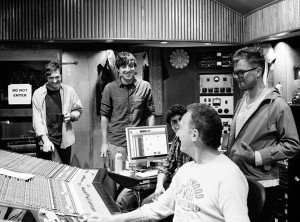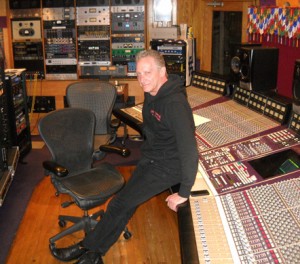Behind The Release: Grizzly Bear Shields
The influential Grizzly Bear album Shields was released 10 years ago. Mixed by Michael Brauer, it has become a fan favorite and a standout record in its genre.
For its 10th anniversary, we’re republishing this profile and interview with Michael Brauer and producer/bandmember Chris Taylor.
The sound of Shields is the last thing you’d expect from a collaboration between the abstract indie rockers Grizzly Bear and a mainstream mixer like Michael Brauer.
Although he’s not well-known outside of the record industry, Brauer is famous within the studio world for being of the dozen or so names that seem to appear on every other breakthrough release from the major labels. He’s even become something of a godfather for an entire style of mixing known as the “multi-bus” approach.
When Grizzly Bear hired Brauer to put the finishing touches on their latest release, I expected what anyone else might: A few healthy coats of gloss and shine, along with a general slickening of the group’s sound. Instead, what the band has delivered is its most organic, and at times, its rawest release since their debut in 2004.
During an age in which the sound of music has become increasingly binary and homogenized, Shields is like a ripe heirloom tomato straight from the farmer’s market: Beautifully and uniquely warped on the outside, pregnant with depth and flavor within.
From the first moments of the album’s opener, “Sleeping Ute,” and its garage-y, decidedly unfinished-sounding drums, Grizzly Bear and Brauer seem to scoff at expected sounds and textures throughout the entirety of Shields.
The Sound
It could be argued that some of the unique sonic character on Grizzly Bear’s earliest releases, Horn of Plenty and Yellow House, came thanks to a degree of technical naïveté. But on Shields, there’s no doubt that the group and their mixer are fully aware of what ‘normal’ records sound like, and how to get there. They just seem not to care.

Shields comes out Sep. 18. Click to stream on NPR.
On “Yet Again,” one of the strongest songs on the album, a kick drum throbs like a muted heartbeat, and cymbals slosh and swirl as if through a veil of molasses. These are the kinds of sounds that tend not to have a place on major releases these days, but the band goes for them with abandon.
I imagine that we’ll hear more and more of these 60s-psychedelia-inspired textures on mainstream releases in coming years, but for now, it takes balls for a “name” mixer to leave sounds this raw, this bare and home-brewed. Initially, I was surprised that an engineer with Brauer’s background signed off on them.
But he did, and in doing so, Brauer managed to get by without triggering the greatest fear that artists like Grizzly Bear tend to have in regards to teaming up with a seasoned professional: Namely, Brauer managed to avoid overworking their music, whitewashing it of their personality, or shoehorning their sound into a preordained aesthetic frame.
This not to say that the album was mixed without care or craft — Far from it. What’s perhaps most impressive about Shields is how much it breathes, and how, in its most dense moments of frenzy, each instrument maintains such clarity and space without losing any of its grit, or its rough, natural edges.
“That’s my favorite thing about the results from these mixes,” Grizzly Bear’s bassist/producer Chris Taylor tells me. “On this record, there are some of the most minimal moments we’ve ever had, and some of the most maximalist as well. The fact that the whole kitchen sink can be present and it can still all make sense to the ear, I think that’s an awesome thing to achieve.”
Clarity in Chaos
The two have decided to meet up for an interview in Brauer’s home away from the city, in the Catskills region of upstate New York. It’s a hot August day around noon, and Taylor sits in a loose-fitting tank top. He has deep-set eyes and a prominent brow that can make him look almost brooding whenever his expression is neutral. But when he laughs – which is often in this conversation – his face is convivial, nearly cherubic.
Brauer, still trim and energetic well into middle-age, has an apparent knack for setting 31-year old Taylor at ease. He has the artless and casual look of a man who’d be as comfortable in the stands at a baseball game as he would be mixing one of the most critically acclaimed and idiosyncratic rock bands of the past ten years.
Even after talking to him at length, Brauer seems very much like a normal, no-nonsense kind of guy who just-so-happens to have a very interesting job. If I had met him at random on the street I might have guessed him for a successful and well-spoken general contractor.
“My goals this year were very, very specific,” he says. “I wanted to mix a record for Dirty Projectors, for Grizzly Bear, and for Twin Shadow.”
“Last year, people wouldn’t have expected me to mix a Grizzly Bear record or a Twin Shadow record; But I did, and when people hear them and they realize they’re awesome, it’s not like ‘Oh shit, he turned it into this’ or ‘he turned it into that.’”
“So my goals were met. Out of the three bands I wanted to do, I got two. And they are both great records. So I couldn’t be happier.”
The rapport between Taylor and Brauer appears to be instant. Taylor had mixed the past Grizzly Bear albums himself, and when he says “This is the first time that I’ve given up that control,” Brauer chimes in immediately: “Which takes balls by the way.”
Both laugh like it’s an exchange that they’ve had a half-dozen times.
“I first thought of asking Brauer to do it when I stopped in during the Twin Shadow mix,” Taylor says. “Having worked on George [Lewis Jr]’s material before, I know what kind of mayhem he presents to a mixer.”
“He makes awesome music,” Taylor adds, “but knowing the kind of chaos that I’m sure he brought in to Brauer, and then hearing what Michael was able to pull out of it – I was like ‘Wow.’ ‘This guy can make sense of something that I know is kind of crazy to make sense of.’”
“So, he was kind of the first person who I ever thought could make sense of our music. Because, well… it’s weird. We have a lot of strange arrangements and we’re very particular about the way we want it all to sound. So to find someone who I could trust, who could make sense of it all — It was really a dream situation.”
Brauer says that with Twin Shadow what he did was “take that mayhem, and just enhance it and focus it a bit more.”
“But I didn’t try to clean it up – which is what I think was his concern. So when Chris walks in, he says ‘I know what that shit usually sounds like. He’s not trying to make it ‘expensive’-sounding. He’s just taking that picture and making it bigger’”
“Exactly,” says Taylor.
Brauer is conscious of the expectations others have for his work, and when I bring it up, he responds readily: “It’s like you said: With most top mixers, you’re expecting ‘the sound.’”
“But I don’t really want to be part of that. I want to be transparent. I just want to take the picture that’s already there and make it huge. Ultimately, Chris thought that sounded like a good idea, and he gave the record up to me – which is just the greatest honor in that respect.”
Surrendering The Mix, Gaining Something Else
The way they tell it, so much of what we hear on Shields is the raw vision of Taylor and the band, filtered and enhanced slightly by an experienced hand.
So if he’s not relying on an outside mixer to radically reshape the sounds, then why did Taylor think it was worthwhile to get a mixer like Brauer involved at such a critical stage?
“Speaking personally, the biggest benefit is not having to worry about it anymore,” Taylor says. “After I’ve recorded and produced the thing, and wrote the thing and played on the thing for 5 months, I don’t want to have to worry about mixing it, too.”
“And there’s also the pressure of not wanting to let my band down. It’s like, yeah, I can mix it and it would be a thing, but it’s just so great to have all of my expectations met and then exceeded, and I didn’t have to do it!” He laughs.
“It was also great to be able to focus on production and on the bigger picture stuff, and not to have to worry about 160hz here and there and get worn out on all that.”
This has become a common realization as more and more self-produced artists graduate into sustainable careers.
“And you can still continue to be the producer when you’re not mixing,” Brauer adds.
“The band isn’t sitting behind me while I’m in the mix. They go off and do their thing, and then when I’m ready for them, they come back. This way Chris can have the same first reaction as the rest of the band. It allows a producer to step back and hear it with fresh ears.”
“You know the way it is. When you’re been involved in it at every step, and you’re mixing it too, there’s a lot of baggage involved in even 8 bars – All the fighting that’s gone into just that one section. But I don’t know any of that. I just know what sounds good to me, and I’m not precious to anything. I’m only precious to what sounds good to my ear and to presenting that.”
It’s clear that the two have immense respect for each other. Taylor is continuously and vocally grateful for Brauer’s hand in the mix, while Brauer for his part, keeps shirking the responsibility for much of it.
The reality of music production today is that seasoned engineers now find themselves working with bands in which there is inevitably at least one young upstart of a would-be producer. The common trope around this dynamic is that it should lead to ego clashes. But these two seem to avoid much of that easily.
“One thing you have to remember,” says Brauer, “is that his reference mixes are a really good reference.”
“If, as a mixer, you’re feeling that you have to put your ‘stamp’ on everything, then you’re going to ignore a lot of things that shouldn’t be ignored. If I’m good to use their stems or I’m good to use their basic balances and their panning, does that make me less of a mixer?” With a man like Brauer, the ‘of course not’ is implied in his very posture.
“The more ideas I like, the more ideas I’ll match in the final mix,” he says. “And with Chris being a mixer, we had this rapport that was there so quickly. I don’t have to re-interpret things, like when some artists say ‘make it more green.‘”
“Or ‘more snowy.‘” Taylor laughs, and nods excitedly in sympathy.
“I’ve had those conversations, and they’re brutal,” Brauer says.
“And if Chris said “300 Hz” I’d believe it. There’s other people who will throw out those numbers and I’m thinking ‘You don’t know what the fuck you’re talking about.’ But with Chris, he knows. There are even times where I’d say to Chris, ‘You do it,’ Because he knew exactly what he wanted. Why not step back and let him do it? It would be done in 2 seconds that way. But you need a lot of confidence to do that.”
Sometimes it takes the most experience to know when not to do anything.
“First of all, recognizing that a particular mix may only need 5% more is something that takes a lot of experience,” says Brauer. “And then, knowing which 5 % is just as important. That 5% could make it bad or make it great. That 5% is enough for them to think ‘This is unbelievable! There’s no way it could be any better.‘”
“Why?” he asks rhetorically, “Because they were already happy with the rough mix! The rough mix was there and all that was needed was a tiny little something. I knew what was there already, and I figured out what it needed. It takes a lot of experience to know when not to get in the way, and when things do need a lot of surgery.”
The flip side is that when Brauer does need to make sweeping changes, he says that he’s going to “have a damn good reason for it.”
“In those situations where something is going to be radically different, I wouldn’t even play the mix for them before giving my defense of why it should be different. And then, I’d play it for them that way three or four times to let them get accustomed to it.”
“If they don’t like it, I can just bring all the faders down and start again. But there are those times when I’d think that they’re hiding something really great that makes the song maybe more vulnerable, or more sensitive, or something like that.
“So sometimes I feel like the defender of the song. And I will defend those ideas. But it’s not from an egotistical standpoint where it’s like ‘My idea is good and your idea sucks, because I’m the mixer and you’re not.’ That doesn’t even enter my mind.”
If Brauer’s goal is transparency, if his aim was to serve the songs and to keep from diluting a distinctive vision, then he seems to have achieved it. But he does admit that he’s had to change aspects of his approach to suit the sound of these singular new bands.
In between mixing artists like Coldplay, John Mayer, Ben Folds, My Morning Jacket, and Fountains of Wayne, and taking a crack at a band like Dirty Projectors or Grizzly Bear, it’s the “little things” he says, the “go-to” effects which he once relied on as a matter of course that he had to train himself to steer away from.
And perhaps a few years ago, Brauer would have been unprepared to work with Grizzly Bear on what might be their greatest record to date. But then again, perhaps Grizzly Bear would have been unprepared to work with someone like Brauer until quite recently as well.
Shields’ Recording
Brauer constantly lauds Taylor’s recording work, which was done on a personal, portable rig based around a 16-channel Mytek converter and Neve sidecar. He has some of Thermionic Culture’s boutique rack gear, a Retro Sta-Level, and even a Nagra field recorder that he used to capture some incidental sounds. They made this recording in a way that was similar to the last two, and spent five to six months between a country house and an old church, writing, arranging and tracking.
“It’s amazing, their choices of instrumentation, and his ability to get each idea across without needing a dozen different tracks for each element,” Brauer says. “It’s just the right idea with just the right sound.”
“That’s a key to great production,” says Brauer. “Sometimes I’m presented with recordings from producers where there are so many different attempts to get one idea across that I end up with 30 different tracks just to create one sound. You could have spent a little more time with getting the right instrumentation and the right idea, but instead I have 30 different tracks to sort through.”
Taylor, though, readily admits that this was once his approach as well, and he wears it as a badge of honor that he has since changed his ways.
“On Yellow House,” he says, “there’d be some little melodic figure and we’d double it with a glockenspiel, and then put a piano on top of that, and then maybe a guitar and then maybe a voice.”
“Ever since then, my goal has been to boil things down to the least number of elements possible. Now there’ll be one track carrying all that weight, and I’ll just leave it alone and let it do its job.”
This is an excellent goal. But I have one caveat about it, and remind Taylor that Yellow House is a great record in its own right. And that it’s a memorable one, partly thanks to its unusual, and perhaps oddly-labored sound.
He laughs, seems appreciative, and maybe a little bit relieved. “Thanks. I am still proud of that one.”
Still, he’s glad to have evolved: “I definitely strive to create a production environment that’s really comfortable for everyone. But yet during Yellow House, I was still learning how I wanted to do things and it took a lot of labor and futzing.
“Now, as long as I capture a good vibe and a good performance and a great moment, I move on. I also record things the way I ultimately want to hear them now, which I think is big. I don’t worry about it if there are effects on the recording, because ultimately, that’s the way I want it to sound anyway. I find the futzing thing to be such a buzzkill now. I’d rather be outside!”
Brauer is into this approach as well. In addition to his respect for the clarity of vision that goes into such a singular presentation of recorded ideas, he says that, “I don’t want to mix 150 channels on the desk. And it’s not because I’m lazy.”
“If you have a stem or a blend that you love, give it to me. I’ve got plenty of other things to do in the mix. Why should I spend five hours recreating your internal stems if you already love them?”
“Some producers think that to get their money’s worth they should have me re-create what they already did. Why? Isn’t there a better use of our time? This isn’t supposed to be difficult. We’re supposed to be having fun. And that’s one of the big differences between today and five years ago. Most of the producers are pre-mixing a bit now, and I think that makes sense.”
Historically, this is how many of our favorite records were made: With commitment to ideas every step of the way. What was a necessity then due to technological limitation, is just plain good advice now.
Brauer also has a detailed hand-off sheet he gives to each artist, and he says that today, he even likes to have people print their plugins.
“Give it to me,” he says. “Today, that’s the chain. If you’ve been living with it and it’s an essential part of your sound, give it to me. Maybe if it has reverb on it, print that separately, because maybe it will limit where I can place it in the mix, but otherwise, give them to me.”
Ultimately, many of the sounds that seem so distinctively “Grizzly Bear” are printed that way by Taylor.
Near the end of the album’s opener, “Sleeping Ute”, a swirling psychedelic euphony collapses into a spare, single voice and acoustic guitar. They are both drenched in the natural sound of what must be a very live – but not enormous – room. Taylor tells me that it was made of stone.
“Motion to Get Emotion”
So if so many of the most meaningful sounds are being realized beforehand, then what exactly is left for a mixer like Brauer to do?
The answer is, the same things that guys like him have been doing for decades. Even when Brauer tries on some due humility and deference for size, it’s apparent that every cell in his body is confident about his work and his aesthetic judgement. Due to the weight of his mixing history, even signing off on these sounds would lend them credibility, just as Grizzly Bear lends credibility to Brauer.
But it’s clear that Brauer is doing more than just signing off. He’s enhanced the textures that were already present, and what strikes me most about the sonic aspect of this album, is how much movement and life it has. These are not static mixes. They breathe and live and evolve or time.
“Yeah, that’s what I do,” Brauer says in a way that somehow sounds ho-hum and self-assured at the same time. “I call it ‘motion to get emotion.’ I’m always riding the vocal, I’m always riding the faders; I’m crescendoing things into a bridge or into a chorus. I have fun. It’s like a performance for me.
“The greatest joy I had in mixing Grizzly Bear is that there’s so much room for that. I was really feeling like I was on stage, like a puppeteer, because there’s so much emotion in their music, so much to move with.
“I really have no idea what I’ve done once the mix is finished. It’s like I get on the train and I want to get off at the right stop, but all of the little stops along the way have no importance to me. The whole experience is kind of a blank, because I find no importance in the technical parts of it. I just remember how it feels when it’s right.
“And I know when I’m in, because when I’m in, I can feel it, physically. I’ll get that sensation and I’ll even scream it out: ‘I’m in!”
“That’s when I turn the computer on, and that’s when writing the automation begins.”
Wrapping it Up
Shields is the kind of album that owes much to its sonic imprint, but isn’t ruled by it. Although there’s no way this album would be the same without its sound, underneath the ‘production’ there are songs that do something unique in and of themselves.
So, after so much discipline and commitment has gone into the writing and recording and mixing, what is the mastering step like? When you know that you already love the album that you have, what do you do in the final step?
“One of the things about the way I mix” says Brauer, “is that… you leave it alone.”
“All of the EQing and compression mastering and all of that stuff, I’ve already done it. So 95% of the time, mastering engineers master it flat, and rarely even make it any louder or quieter or anything. It’s presented to them as done.”
“The most important thing then is to find the right mastering engineer, who is going to understand that. We ended up going with [Bob] Ludwig. He was sensitive to what was going on, and he works so well in so many different styles.”
This is a tricky step, because so many mastering engineers today have come to think that they have to apply a stamp to a record, to dazzle the client with gratuitous extra depth and width and loudness to prove their worth. This, however, is exactly what the Brauer and the band have managed to avoid every step of the way.
“It was mostly about trying to maintain what was already there,” says Taylor. “We knew that we already loved the mixes.”
And it’s a funny thing: Brauer had said the same thing about the recording.
Justin Colletti is a Mastering engineer who writes and talks about music and how we make it.
This article was originally published September 13th, 2012. We are republishing it in honor of the album’s 10th anniversay.
Please note: When you buy products through links on this page, we may earn an affiliate commission.











Yup
September 13, 2012 at 8:18 pm (13 years ago)Wish there was more tech talk. Too much mushy back-slapping for my taste…
Justin Colletti
September 13, 2012 at 5:26 pm (13 years ago)This article isn’t intended to be about technology. It’s about music, people and process, which are ultimately, far more important.
If you’d prefer a technical story, try my audio history of the AKG 414:
http://trustmeimascientist.com/2011/09/05/curing-condenser-confusion-an-audio-history-of-the-akg-c-414/
Or this article on A-B testing and high-definition audio:
http://trustmeimascientist.com/2012/05/05/results-from-our-audio-poll-neil-young-and-high-definition-sound/
Or this one on drum tuning:
https://www.sonicscoop.com/2011/07/28/studio-skillset-drum-tuning-essentials/
Or this one on new mic designs:
https://www.sonicscoop.com/2011/11/10/made-in-ny-ronin-applied-sciences/
Or check out the Input|Output page for in-depth reviews and interviews with top engineers and gear designers:
https://www.sonicscoop.com/category/podcast/
I love tech talk at times as well, but having too much of it can be corrosive to music. And in excess, it can easily cause us to miss the most crucial and meaningful lessons about our work.
Anyway, hope you do enjoy some of those stories above. They’re fun too.
andrew
October 28, 2013 at 1:30 pm (12 years ago)the REASONS BEHIND the back-slapping trump the need for tech talk… the point is that the productions and instincts were more important than the tools and mix process. this is clearly the angle of the article!!
Robert Johnson
July 7, 2015 at 8:54 pm (10 years ago)This article and the album is a classic remake of ‘The Emperor’s Clothes’. I’m sorry but this record sounds like crap. The songs are great+ also a huge fan of MB’s work (Athlete, …) but the mix is awful.
Justin C.
October 6, 2015 at 12:53 pm (10 years ago)It is indeed a very unusual mix, that doesn’t sound “polished” in quite the way that we expect a more mainstream Brauer mix to sound. And to be honest, that was one of the things that intrigued me most about this one, and made me want to write about it.
It’s dark and swirling, and at times kick drums are pillowy-sounding and there are all sorts of raw and unexpected tones. To my ear, it sounds like it comes from another era. You may or may not like it, but it’s hard to argue that it is at least very interesting.
That’s my take anyway! You are welcome to your own. Thanks for sharing it.